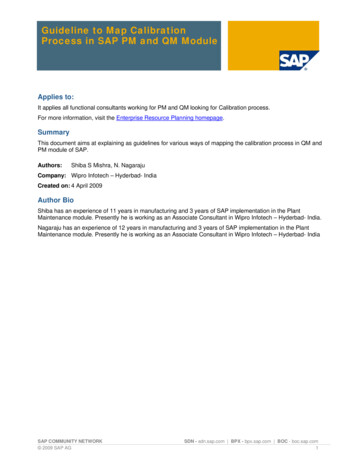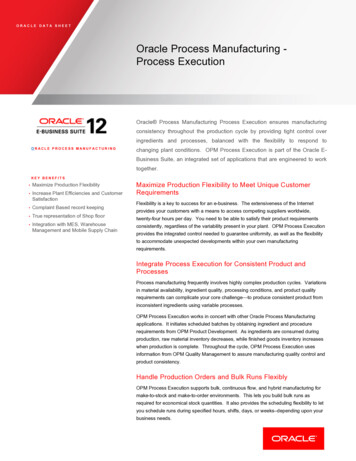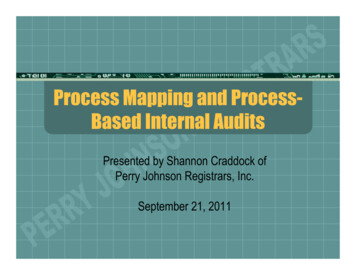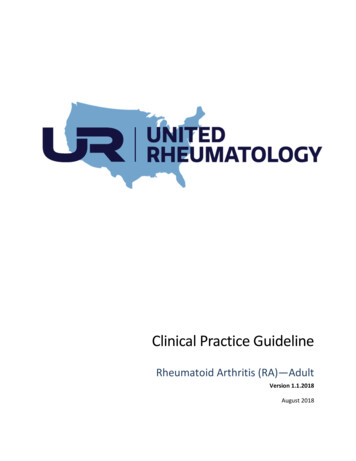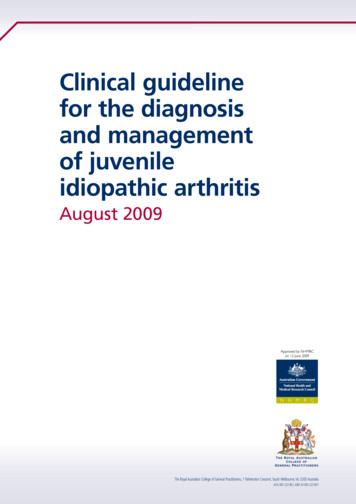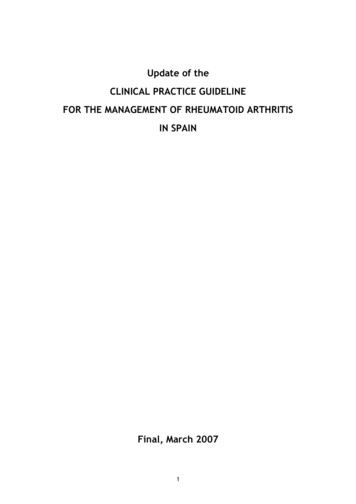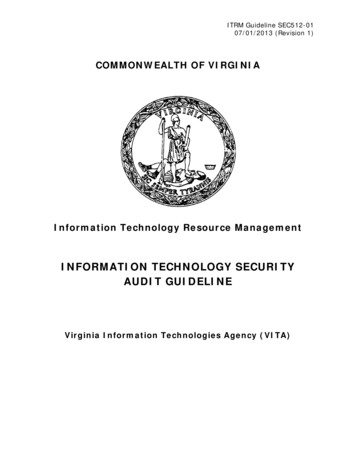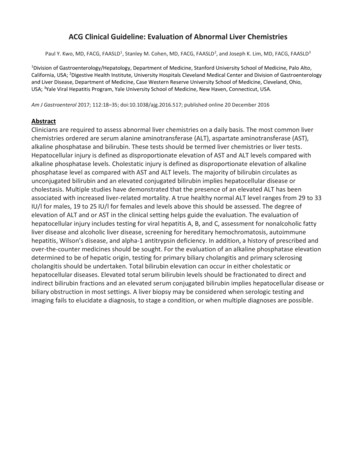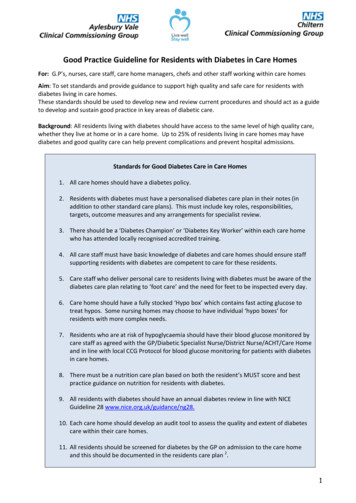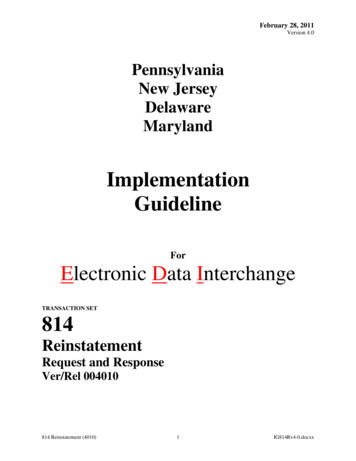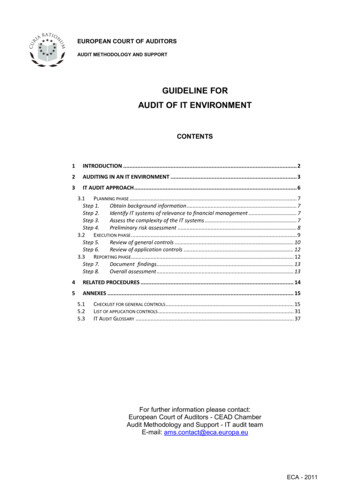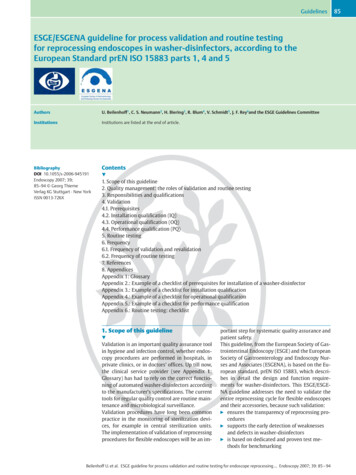
Transcription
GuidelinesESGE/ESGENA guideline for process validation and routine testingfor reprocessing endoscopes in washer-disinfectors, according to theEuropean Standard prEN ISO 15883 parts 1, 4 and 5AuthorsU. Beilenhoff1, C. S. Neumann2, H. Biering3, R. Blum4, V. Schmidt5, J. F. Rey6and the ESGE Guidelines CommitteeInstitutionsInstitutions are listed at the end of article.BibliographyDOI 10.1055/s-2006-945191Endoscopy 2007; 39;85–94 Georg ThiemeVerlag KG Stuttgart · New YorkISSN 0013-726XContents!1. Scope of this guideline2. Quality management: the roles of validation and routine testing3. Responsibilities and qualifications4. Validation4.1. Prerequisites4.2. Installation qualification (IQ)4.3. Operational qualification (OQ)4.4. Performance qualification (PQ)5. Routine testing6. Frequency6.1. Frequency of validation and revalidation6.2. Frequency of routine testing7. References8. AppendicesAppendix 1: GlossaryAppendix 2.: Example of a checklist of prerequisites for installation of a washer-disinfectorAppendix 3.: Example of a checklist for installation qualificationAppendix 4.: Example of a checklist for operational qualificationAppendix 5.: Example of a checklist for performance qualificationAppendix 6.: Routine testing: checklist1. Scope of this guideline!Validation is an important quality assurance toolin hygiene and infection control, whether endoscopy procedures are performed in hospitals, inprivate clinics, or in doctors’ offices. Up till now,the clinical service provider (see Appendix 1:Glossary) has had to rely on the correct functioning of automated washer-disinfectors accordingto the manufacturer’s specifications. The currenttools for regular quality control are routine maintenance and microbiological surveillance.Validation procedures have long been commonpractice in the monitoring of sterilization devices, for example in central sterilization units.The implementation of validation of reprocessingprocedures for flexible endoscopes will be an im-portant step for systematic quality assurance andpatient safety.This guideline, from the European Society of Gastrointestinal Endoscopy (ESGE) and the EuropeanSociety of Gastroenterology and Endoscopy Nurses and Associates (ESGENA), is based on the European standard, prEN ISO 15883, which describes in detail the design and function requirements for washer-disinfectors. This ESGE/ESGENA guideline addresses the need to validate theentire reprocessing cycle for flexible endoscopesand their accessories, because such validation:" ensures the transparency of reprocessing procedures" supports the early detection of weaknessesand defects in washer-disinfectors" is based on dedicated and proven test methods for benchmarkingBeilenhoff U. et al. ESGE guideline for process validation and routine testing for endoscope reprocessing Endoscopy 2007; 39: 85 – 9485
86GuidelinesQM of WD manufacturerQuality management of clinical service providerType TestValidationRoutine TestDetailed analysis of each processparameter and of the completereprocessing cycleEvaluation of reprocessingperformance under conditionsat the point of useEvaluation of outcomequality by technical andmicrobiological testsTest, showing conformity of theWD with the prEN ISO 15883.Check of pre-requisitesFigure 1 Quality Management for reprocessing offlexible endoscopes.Testing of:Installation qualificationEndoscopesOperational qualificationWDPerformance qualificationWaterhas the potential to reduce the amount of routine testingThis guideline is an expert opinion and provides practical information about and guidance through the validation of the entireprocedure of reprocessing with washer-disinfectors. Examplechecklists are provided to support the implementation of validation at each individual endoscopy unit."Aims of this guidelineThese are:To support individual endoscopy departments and clinicalservice providers in establishing local standards and protocols for validation processes for endoscope reprocessing withwasher-disinfectors" To support national societies and official bodies in developingnational recommendations for the validation of proceduresfor reprocessing flexible endoscopes"Target groupsThis guideline provides practical guidance through the validation process for the following groups:" Clinical service providers, as they have the responsibility tomeet structural and organizational requirements and to provide educated staff, for the safe use of washer-disinfectors" Endoscopists, endoscopy nurses, and other users of washerdisinfectors, who use flexible endoscopes and who areresponsible for the safe reprocessing of endoscopy equipment" Hospital hygienists, microbiological personnel, microbiologists, and authorized agencies, who perform regular microbiological quality control in endoscopy units" Manufacturers, suppliers, and authorized third parties whosell, install, and maintain flexible endoscopes and washerdisinfectors for gastrointestinal endoscopy" Institutions, companies, and other qualified agencies that areauthorized to perform validation of washer-disinfectors2. Quality management: the roles of validation androutine testing!The European standard prEN ISO 15 883 consists of five parts, ofwhich three are relevant to endoscopy:" Part 1 states the general requirements and definitions for allwasher-disinfectors." Part 4 defines the special requirements for the design ofwasher-disinfectors and for reprocessing of heat-sensitiveinstruments such as thermolabile, flexible endoscopes. Inaddition, prEN ISO 15 883 – 4 requires a check on whether thecorrect reprocessing results are obtained with all endoscopetypes to be reprocessed under the particular circumstancesobtaining at the service provider’s location (water quality,power supply etc.). This process is called validation." Part 5 provides test soils and methods for demonstrating thecleaning efficacy of washer-disinfectors.Quality assurance systems for washer-disinfectors comprise" Figure 1), type testing, validation, and routinethree parts (see ltesting.1. Type testing according to prEN ISO 15883, is the responsibilityof the manufacturer and checks that the washer-disinfectorcomplies with the prEN ISO 15 883 standard. During type testing,each individual step of the reprocessing cycle is separately analyzed (e. g. cleaning efficacy, disinfection efficacy, water quality,chemicals), followed by evaluation of the reprocessing cycle as awhole. In addition, type testing provides reference data for further validation and use of the washer-disinfectors.2. Validation is the responsibility of the clinical service provider.It demonstrates that the entire reprocessing procedure gives reproducible results at the point of use as required. Single parameters can be defined as indicators. The validation process forwasher-disinfectors includes the following steps:" Installation qualification (IQ), to check that the equipment isreceived as specified, that it is correctly installed, and that theparticular location is suitable for the use of the washer-disinfector" Operational qualification (OQ), to check that the washer-disinfector will operate as specified in the endoscopy unit concerned" Performance qualification (PQ), to check that the washer-disinfector consistently performs according to the specificationfor routine useValidation must be repeated (revalidation):" on a regular basis (according to national requirements)," after each major change of the reprocessing cycle, or" after major repair.This is in order to document that the reprocessing process stillachieves the same required, reproducible results.3. Routine testing is the responsibility of the clinical service provider. Based on the validation results, routine tests are established in order to prove that the washer-disinfector works withinthe defined limits for dedicated parameters and to prove theoutcome quality of the complete reprocessing cycle. Routine testing may include tests of endoscopes, washer-disinfectors, andthe water used in the particular department. An appropriatesampling plan has to be established for each type of washer-disinfector.This guideline focuses on the validation process (including installation, operational, and performance qualification) and onthe routine testing.Beilenhoff U. et al. ESGE guideline for process validation and routine testing for endoscope reprocessing Endoscopy 2007; 39: 85 – 94
GuidelinesValidationResponsibilityOption for ExecutionQualificationPrerequisitesClinical Service ProviderManufacturerAuthorised SupplierAuthorised third partyExpertise in regulatoryissues technical and electrical issues of WD, chemicals, flexible endoscopesand special equipmentManufacturerAuthorised SupplierAuthorised third party,Endoscopy staffMicrobiological institutesMicrobiological staffHygienistsInfection control nursesMicrobiological expertiseTechnical understandingof the WDIQClinical Service ProviderOQClinical Service ProviderPQClinical Service ProviderRoutine testsClinical Service Provider3. Responsibilities and qualifications!It is the responsibility of the clinical service provider to ensurethat validation is carried out. Validation must be done at the location where the washer-disinfector is being used. A qualifiedcompany/person may carry out validation on behalf of the clinical service provider. It is strongly recommended that the company or persons performing such validation have expert knowledge in all relevant areas such as microbiology, hygiene and infection control, technical and electrical issues relating to washer-disinfectors, chemicals, flexible endoscopes, and regulatoryissues.The clinical service provider must document all the relevant validation data for the washer-disinfector, and the use of standardchecklists is recommended. This guideline provides examples ofchecklists [1] which can be adapted to local structures and therequirements of particular clinical settings (see section 8, Appendices 2 – 6.)Installation qualification is usually performed by the manufacturer, the supplier, or authorized third parties.Operational qualification is the responsibility of the clinical service provider. Specialized knowledge will be required about:technical and electrical issues relating to washer-disinfectors;chemicals; flexible endoscopes; regulatory issues; and specialequipment. Therefore it is recommended that authorized andspecially trained persons perform this validation. The manufacturer of the washer-disinfectors must provide instructionson how to test the various process parameters and functions ofeach washer-disinfector. The manufacturer may also need tosupply appropriate specialized test equipment.Performance qualification is the responsibility of the clinical service provider. Only persons or organizations with appropriatemicrobiological expertise should carry out these tests. Additionally, such persons or organizations should have a thorough understanding of the structure and function of the tested washerdisinfectors and endoscopes.Routine testing is the responsibility of the clinical service provider. The tests may cover technical and microbiological parameters, and should therefore be performed by appropriate trainedpersons. Collection, culturing, and the interpretation of test results should be done in close cooperation with endoscopy staff,the hospital hygienist, appropriate microbiology personnel, andthe microbiologist, in line with national requirements.Table 1 Responsibilities andQualification in Quality management of validationAn example of the procedures and expertise required for valida" Tation and routine testing has been published recently [2]; lble 1 shows these, linked with the appropriate organizationsand personnel needed to carry out the procedures.4. Validation!4.1. PrerequisitesThe endoscopy department or unit must fulfil technical and organizational prerequisites. A purpose-designed room for cleaning and disinfection that is separate from procedure rooms isrecommended, to minimize patient and staff exposure to:" chemicals used in cleaning and disinfection procedures (e. g.because of toxic/allergic reactions, glutaraldehyde vapour)" the risk of infection and contamination with potentially infectious material, blood and other body fluids.The manufacturer must provide information about the structureand function of the washer-disinfector. The validation can beperformed when the washer-disinfector is installed accordingto the manufacturer’s instructions and local safety regulations,and when all components and utilities are available.The checklist in Appendix 2 is an example of what should beconsidered. It is based on the recommendations of the ESGE Guidelines Committee and relevant European guidelines [3, 4].4.2. Installation qualification (IQ)Installation qualification is the process of obtaining and documenting evidence that the washer-disinfector has been suppliedand installed in accordance with its specifications. Checks needto be carried out that all ordered items have been received andthat the location of the washer-disinfector correctly fulfils specifications (e. g. with regard to water quality, power supply, etc.).An example of a checklist is shown in Appendix 3.4.3. Operational qualification (OQ)Operational qualification is the process of obtaining and documenting evidence that the installed washer-disinfector operateswithin predetermined limits when used in accordance with itsoperational procedures. For example, checks are needed toshow whether:" the leak test and the flow control function in accordancewithin their specifications,Beilenhoff U. et al. ESGE guideline for process validation and routine testing for endoscope reprocessing Endoscopy 2007; 39: 85 – 9487
88Guidelinesthe temperature profile is in line with specifications, andthe dosage pumps for the chemicals deliver the right quantities.A standardized checklist is available in Appendix 4.""4.4. Performance qualification (PQ)Performance qualification is the process of obtaining and documenting
ESGE/ESGENA guideline for process validation and routine testing for reprocessing endoscopes in washer-disinfectors, according to the European Standard prEN ISO 15883 parts 1, 4 and 5 Authors U. Beilenhoff1, C. S. Neumann2, H. Biering3, R. Blum4, V. Schmidt5,J.F.Rey6and the ESGE Guidelines Committee Institutions Institutions are listed at the end of article. Bibliography DOI 10.1055/s-2006 .
